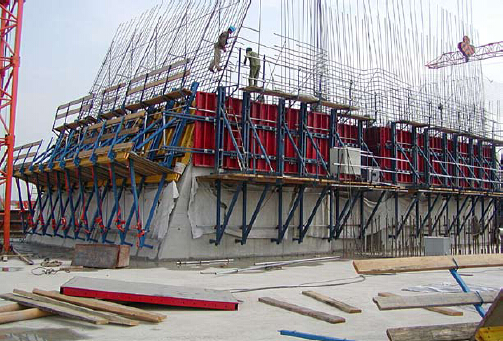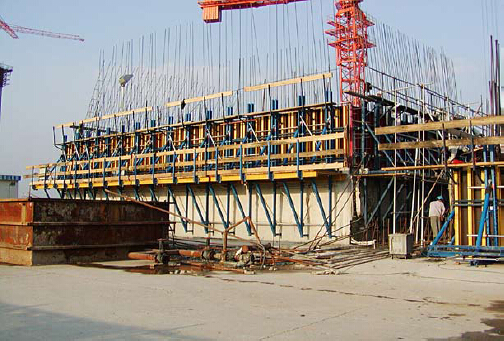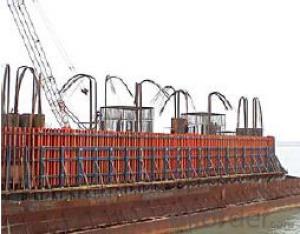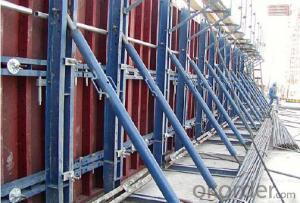Single Side Climbing Bracket SCB180 for formwork and scaffolding system
- Loading Port:
- Tianjin
- Payment Terms:
- TT OR LC
- Min Order Qty:
- 50 m²
- Supply Capability:
- 1000 m²/month
OKorder Service Pledge
OKorder Financial Service
You Might Also Like
Single-side Climbing Bracket SCB180:
With CNBM SCB 180 climbing systems, the loads from the fresh concrete pressure are transferred through the brackets by means of V-strongbacks and compression braces into the scaffold anchors.
Typical applications for the SCB 180 are dams, locks, cooling towers, pier heads, tunnels, and bank vaults.
The formwork is simply tilted backwards when striking takes place. The 1.80 m wide bracket requires only a minimum of space.
Characteristics:
◆ Economical and safe anchoring
The M30/D20 climbing cones have been designed especially for single-sided concreting using
SCB180 in dam construction, and to allow the transfer of high tensile and shear forces into the still
fresh, unreinforced concrete. Without wall-through tie-rods, finished concrete is perfect.
◆ Stable and cost-effective for high loads
generous bracket spacings allow large-area formwork units with optimal utilization of the bearing
capacity. This leads to extremely economical solutions.
◆ Simple and flexible planning
With SCB180 single-sided climbing formwork, circular structures can also be concreted without
undergoing any large planning process. Even use on inclined walls is feasible without any special
measures because additional concrete loads or lifting forces can be safely transferred into the
structure.


- Q: What are the considerations when designing steel formwork for swimming pools?
- When designing steel formwork for swimming pools, there are several important considerations to take into account. These considerations include the structural integrity and strength of the formwork, the accuracy and precision of the formwork's dimensions, the ease of assembly and disassembly, and the ability to withstand the corrosive effects of water and pool chemicals. Firstly, the structural integrity and strength of the steel formwork are crucial. The formwork must be able to support the weight and pressure exerted by the concrete during pouring and curing. It should be designed to resist any potential deformation or buckling that could compromise the pool structure. The thickness and reinforcement of the steel must be carefully calculated to ensure it meets the required load-bearing capacity. The accuracy and precision of the formwork's dimensions are also important considerations. The formwork should be designed to provide precise and consistent dimensions to ensure the pool's shape and size are accurately maintained. This is particularly critical for swimming pools, where any deviation from the intended design may result in uneven water levels or compromised aesthetic appeal. Ease of assembly and disassembly is another consideration. The formwork should be designed for easy installation and removal to facilitate efficient construction processes. The components should be designed to fit together securely and allow for quick adjustments or modifications if necessary. This can help reduce construction time and labor costs. Furthermore, the corrosive effects of water and pool chemicals need to be taken into account. Steel formwork should be treated or coated with materials that can withstand the exposure to water and chemicals commonly found in swimming pools. This helps prevent rust and deterioration, ensuring the longevity and durability of the formwork. In conclusion, designing steel formwork for swimming pools requires careful consideration of structural integrity, dimensional accuracy, ease of assembly, and resistance to corrosion. By addressing these considerations, the formwork can provide a solid foundation for the construction of a high-quality and long-lasting swimming pool.
- Q: How is steel formwork transported to the construction site?
- Steel formwork is typically transported to the construction site by using trucks or trailers equipped with cranes or forklifts. The formwork is securely loaded onto the vehicle and then transported to the site, where it is unloaded and positioned for use in the construction process.
- Q: How does steel formwork contribute to the sustainability of the construction industry?
- Steel formwork contributes to the sustainability of the construction industry in several ways. Firstly, steel formwork is highly durable and long-lasting. Unlike traditional wooden formwork, which often needs to be replaced after a few uses, steel formwork can be reused multiple times, reducing the need for new materials and minimizing waste. This not only saves money for construction companies but also reduces the environmental impact of the industry by reducing the demand for timber. Secondly, steel formwork is more efficient and time-saving compared to other types of formwork. The use of steel allows for faster assembly and disassembly, reducing construction time and costs. This efficiency translates into reduced energy consumption and lower carbon emissions, thereby contributing to the sustainability of the construction process. Moreover, steel formwork offers flexibility and adaptability in design, allowing for the construction of complex structures with ease. This versatility reduces the need for additional materials and resources, as the same formwork can be used for various projects. This adaptability also minimizes construction waste, further enhancing the sustainability of the industry. Additionally, steel formwork has a high load-bearing capacity, enabling the construction of taller and stronger structures. This means that fewer materials are required to achieve the same structural integrity, reducing resource consumption and waste generation. The ability to construct more durable buildings also contributes to the long-term sustainability of the construction industry by reducing the need for frequent repairs or replacements. Lastly, steel formwork is recyclable. At the end of its lifespan, steel formwork can be easily and efficiently recycled, reducing the demand for new steel production and minimizing the environmental impact associated with its extraction and manufacturing. In conclusion, steel formwork contributes to the sustainability of the construction industry through its durability, efficiency, flexibility, load-bearing capacity, and recyclability. Its ability to reduce waste, energy consumption, and carbon emissions makes it an environmentally-friendly choice for construction projects, promoting a more sustainable and responsible construction industry.
- Q: Can steel formwork be used for both horizontal and vertical construction elements?
- Yes, steel formwork can be used for both horizontal and vertical construction elements. Steel formwork is versatile and can be easily adapted to different shapes and sizes, making it suitable for various construction applications.
- Q: How does steel formwork contribute to the overall efficiency of concrete construction?
- Steel formwork contributes to the overall efficiency of concrete construction in several ways. Firstly, steel formwork is known for its durability and strength, allowing it to withstand the pressure exerted by wet concrete during the pouring and curing process. This durability ensures that the formwork remains intact and stable, reducing the risk of collapse and ensuring the safety of workers. Secondly, steel formwork is highly versatile and can be easily customized to meet the specific requirements of a construction project. It can be easily adjusted and modified to create different shapes and sizes, allowing for the construction of complex and intricate concrete structures. This flexibility in design helps to optimize the use of concrete and minimize wastage, ultimately reducing material and labor costs. Furthermore, steel formwork is reusable, making it a cost-effective solution for multiple construction projects. Unlike other formwork materials such as wood or plastic, steel formwork can be dismantled and reused multiple times without compromising its structural integrity. This not only saves money, but also reduces the environmental impact associated with construction waste. Additionally, steel formwork offers a smooth and even surface finish to the concrete, enhancing the aesthetics of the final structure. This is particularly important for architectural projects where the appearance of the concrete is a key consideration. The use of steel formwork ensures that the concrete surface is free from imperfections, resulting in a high-quality finish. Lastly, the use of steel formwork streamlines the construction process by reducing the time required for formwork installation and removal. Steel formwork systems are designed to be easily assembled and disassembled, saving valuable time during the construction process. This increased efficiency allows for faster project completion and reduced labor costs. In conclusion, steel formwork significantly contributes to the overall efficiency of concrete construction through its durability, versatility, reusability, aesthetic enhancements, and time-saving benefits. By utilizing steel formwork, construction projects can be completed more efficiently, cost-effectively, and with higher quality results.
- Q: How does steel formwork affect the overall safety of construction workers?
- Steel formwork can significantly enhance the overall safety of construction workers due to its robust and durable nature. Steel formwork provides a sturdy framework, ensuring stability and preventing collapses or accidents during concrete pouring and curing processes. Its strength and rigidity also minimize the risk of formwork failure, reducing the chances of injuries caused by falling debris or equipment. Additionally, steel formwork offers better fire resistance compared to other materials, further enhancing the safety of construction workers by reducing the potential for fire-related hazards.
- Q: How does steel formwork affect the overall aesthetics of the structure?
- Steel formwork typically does not directly affect the overall aesthetics of a structure as it is used as a temporary mold to shape the concrete during construction. However, steel formwork can indirectly impact the aesthetics by facilitating precise and smooth concrete finishes, resulting in a more visually appealing final product.
- Q: What are the considerations when designing steel formwork for slabs with openings?
- When designing steel formwork for slabs with openings, several key considerations need to be taken into account. These include the size and location of the openings, the required load-bearing capacity of the formwork, the method of supporting the formwork, and the ease of installation and removal. Additionally, factors such as safety, durability, and cost-effectiveness should also be considered during the design process.
- Q: What are the different components of steel formwork?
- Steel formwork, which is utilized in construction projects, acts as a temporary structure that offers support and shape to concrete while it cures. This formwork system is composed of several components that collaborate to establish a sturdy and long-lasting structure. The key components of steel formwork comprise: 1. Panels: These are the primary elements of the formwork system and are commonly constructed with steel or steel-reinforced plywood. They are obtainable in various sizes and shapes and can be effortlessly interconnected to create the desired formwork configuration. 2. Soldiers: These vertical members provide support to the formwork panels. Usually made of steel, they are adjustable in height, allowing for flexibility in the formwork design. Soldiers are connected to the panels using connecting clamps or pins. 3. Waler Beams: These horizontal members aid in distributing the load evenly across the formwork system. Waler beams are connected to the soldiers using clamps or brackets and are typically made of steel or aluminum. 4. Tie Rods: These are utilized to hold the formwork panels and soldiers together. They are threaded rods that pass through the panels and are secured with nuts and washers on each side. Tie rods help maintain the required spacing between the panels and provide additional strength to the formwork system. 5. Formwork Accessories: These consist of various components like clamps, brackets, wedges, and pins, which are employed to connect and secure the formwork elements. They assist in maintaining the stability and alignment of the formwork system during concrete pouring and curing. 6. Formwork Joints: These specially designed connectors allow for easy assembly and disassembly of the formwork system. They ensure proper alignment and tightness of the formwork components, preventing concrete leakage and maintaining the desired shape. 7. Formwork Supports: These are used to provide additional support to the formwork system, particularly for larger and complex structures. Formwork supports can take the form of props, scaffolding, or specialized shoring systems, depending on the specific project requirements. In summary, these components collaborate to establish a robust and stable formwork system capable of withstanding the pressure and weight of the concrete during the construction process. Steel formwork is favored for its durability, reusability, and ease of assembly and disassembly, making it a popular choice in modern construction projects.
- Q: Can steel formwork be used for industrial flooring?
- Yes, steel formwork can be used for industrial flooring. Steel formwork is known for its durability and strength, making it suitable for heavy-duty applications such as industrial flooring. It can withstand the weight and pressure exerted by heavy machinery and equipment, providing a stable and sturdy base for industrial operations. Additionally, steel formwork offers the advantage of being reusable, which makes it a cost-effective choice for flooring in industrial settings.
Send your message to us
Single Side Climbing Bracket SCB180 for formwork and scaffolding system
- Loading Port:
- Tianjin
- Payment Terms:
- TT OR LC
- Min Order Qty:
- 50 m²
- Supply Capability:
- 1000 m²/month
OKorder Service Pledge
OKorder Financial Service
Similar products
Hot products
Hot Searches


















